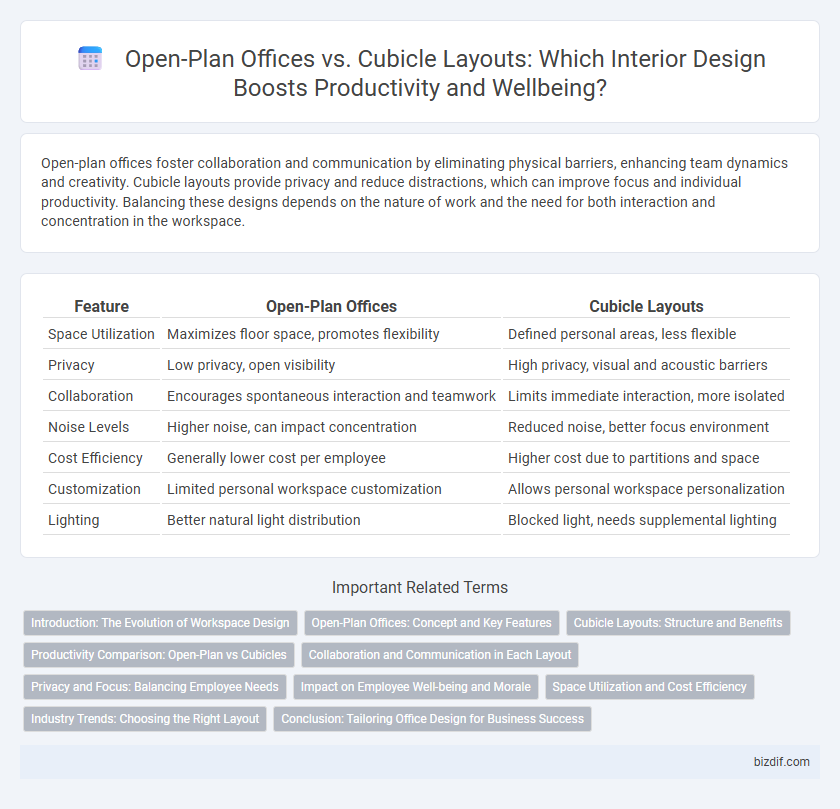Open-plan offices foster collaboration and communication by eliminating physical barriers, enhancing team dynamics and creativity. Cubicle layouts provide privacy and reduce distractions, which can improve focus and individual productivity. Balancing these designs depends on the nature of work and the need for both interaction and concentration in the workspace.
Table of Comparison
| Feature | Open-Plan Offices | Cubicle Layouts |
|---|---|---|
| Space Utilization | Maximizes floor space, promotes flexibility | Defined personal areas, less flexible |
| Privacy | Low privacy, open visibility | High privacy, visual and acoustic barriers |
| Collaboration | Encourages spontaneous interaction and teamwork | Limits immediate interaction, more isolated |
| Noise Levels | Higher noise, can impact concentration | Reduced noise, better focus environment |
| Cost Efficiency | Generally lower cost per employee | Higher cost due to partitions and space |
| Customization | Limited personal workspace customization | Allows personal workspace personalization |
| Lighting | Better natural light distribution | Blocked light, needs supplemental lighting |
Introduction: The Evolution of Workspace Design
Open-plan offices have transformed workspace design by promoting collaboration and flexibility, contrasting sharply with traditional cubicle layouts that emphasize individual privacy and reduced distractions. The shift reflects changing organizational priorities towards fostering creativity, communication, and dynamic workflows in modern interior design. Advancements in ergonomic furniture, acoustic solutions, and spatial zoning now bridge the gap between openness and the need for focused work environments.
Open-Plan Offices: Concept and Key Features
Open-plan offices prioritize flexible, collaborative workspaces by minimizing physical barriers and encouraging interaction between employees. Key features include large, shared desks, adjustable furniture, and the integration of natural light to enhance productivity and well-being. This design fosters transparency and communication but requires strategic noise control and privacy solutions to maintain focus.
Cubicle Layouts: Structure and Benefits
Cubicle layouts in office design provide distinct personal workspaces that enhance employee focus and privacy by minimizing visual and auditory distractions. The modular structure allows for efficient use of space while enabling customization to fit individual or team needs, improving organization and workflow. These enclosed areas foster a sense of ownership and can reduce noise levels, contributing to increased productivity and comfort in busy office environments.
Productivity Comparison: Open-Plan vs Cubicles
Open-plan offices foster collaboration and communication, often enhancing creativity and teamwork but may suffer from increased noise and distractions that reduce individual productivity. Cubicle layouts provide privacy and reduce interruptions, promoting focused work and higher concentration levels, yet they can limit spontaneous interactions and hinder team dynamics. Balancing open spaces with designated quiet zones often yields the most effective environment for diverse productivity needs.
Collaboration and Communication in Each Layout
Open-plan offices enhance collaboration by encouraging spontaneous interactions and easy communication among team members, fostering a dynamic and creative work environment. Cubicle layouts provide employees with privacy and reduced distractions, which can improve focus but may limit face-to-face communication and teamwork. Balancing open spaces with designated quiet zones can optimize collaboration while supporting individual productivity in office design.
Privacy and Focus: Balancing Employee Needs
Open-plan offices promote collaboration but often struggle with noise and visual distractions, reducing employee focus and privacy. Cubicle layouts create individual workspaces that enhance concentration and confidentiality, yet can hinder communication and openness. Balancing these needs requires integrating soundproofing, adjustable partitions, and designated quiet zones to support both privacy and teamwork effectively.
Impact on Employee Well-being and Morale
Open-plan offices promote collaboration and natural light exposure, enhancing employee well-being and fostering a sense of community, but may increase noise levels and distractions that reduce focus. Cubicle layouts provide privacy and personalized space, improving concentration and reducing stress for tasks requiring deep focus, yet can feel isolating and hinder spontaneous interaction. Balancing these layouts with ergonomic furniture, soundproofing, and biophilic elements is essential to optimize morale and productivity.
Space Utilization and Cost Efficiency
Open-plan offices maximize space utilization by eliminating partitions, allowing for flexible furniture arrangements that accommodate more employees per square foot. Cubicle layouts, while offering privacy, often consume more space and increase costs due to additional materials and installation requirements. Businesses seeking cost efficiency typically favor open-plan designs for their lower construction and maintenance expenses.
Industry Trends: Choosing the Right Layout
Open-plan offices dominate current interior design trends due to their promotion of collaboration and flexible workspaces, appealing to tech and creative industries. Cubicle layouts, while declining in popularity, remain favored in sectors prioritizing privacy and focused individual tasks, such as finance and legal firms. Hybrid designs combining open spaces with private pods present a balanced solution, optimized for productivity and employee well-being according to recent industry studies.
Conclusion: Tailoring Office Design for Business Success
Open-plan offices foster collaboration and communication, boosting creativity and team dynamics, while cubicle layouts offer privacy and reduced distractions, enhancing focus and individual productivity. Businesses must analyze their specific work culture, employee needs, and nature of tasks to determine the optimal office design. Tailoring the workspace strategically balances interaction with concentration, driving overall operational efficiency and employee satisfaction.
Open-plan offices vs Cubicle layouts Infographic

 bizdif.com
bizdif.com